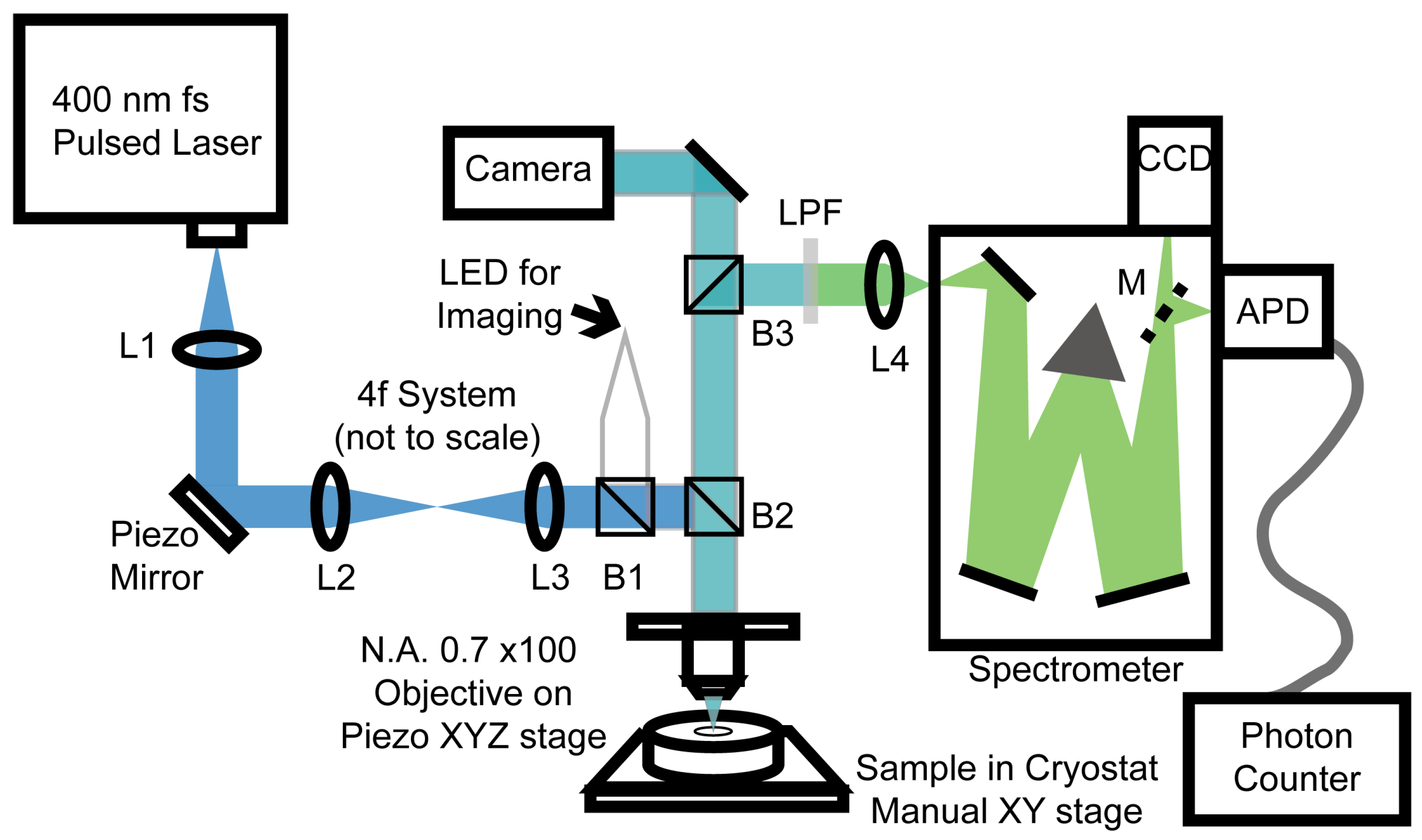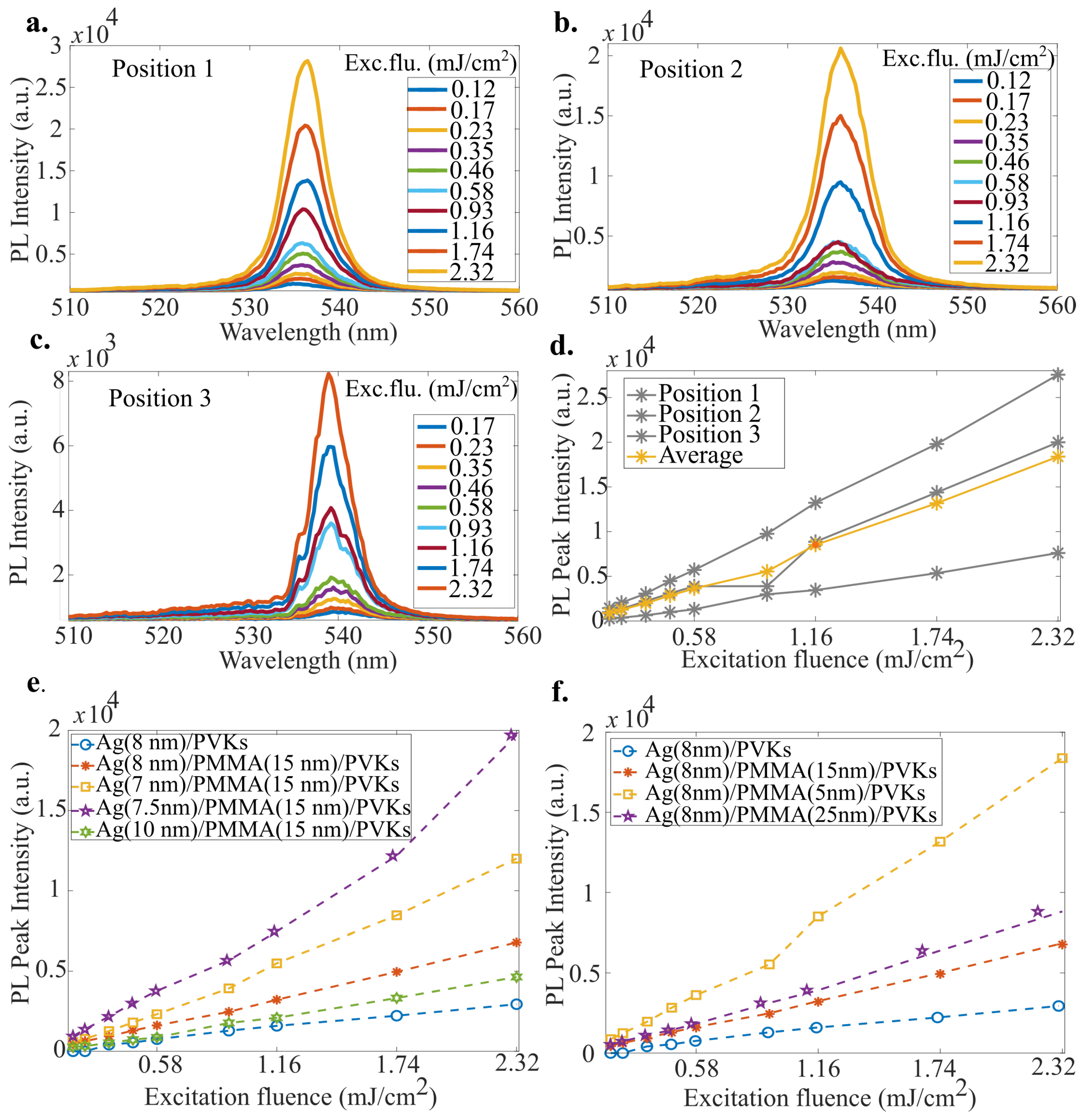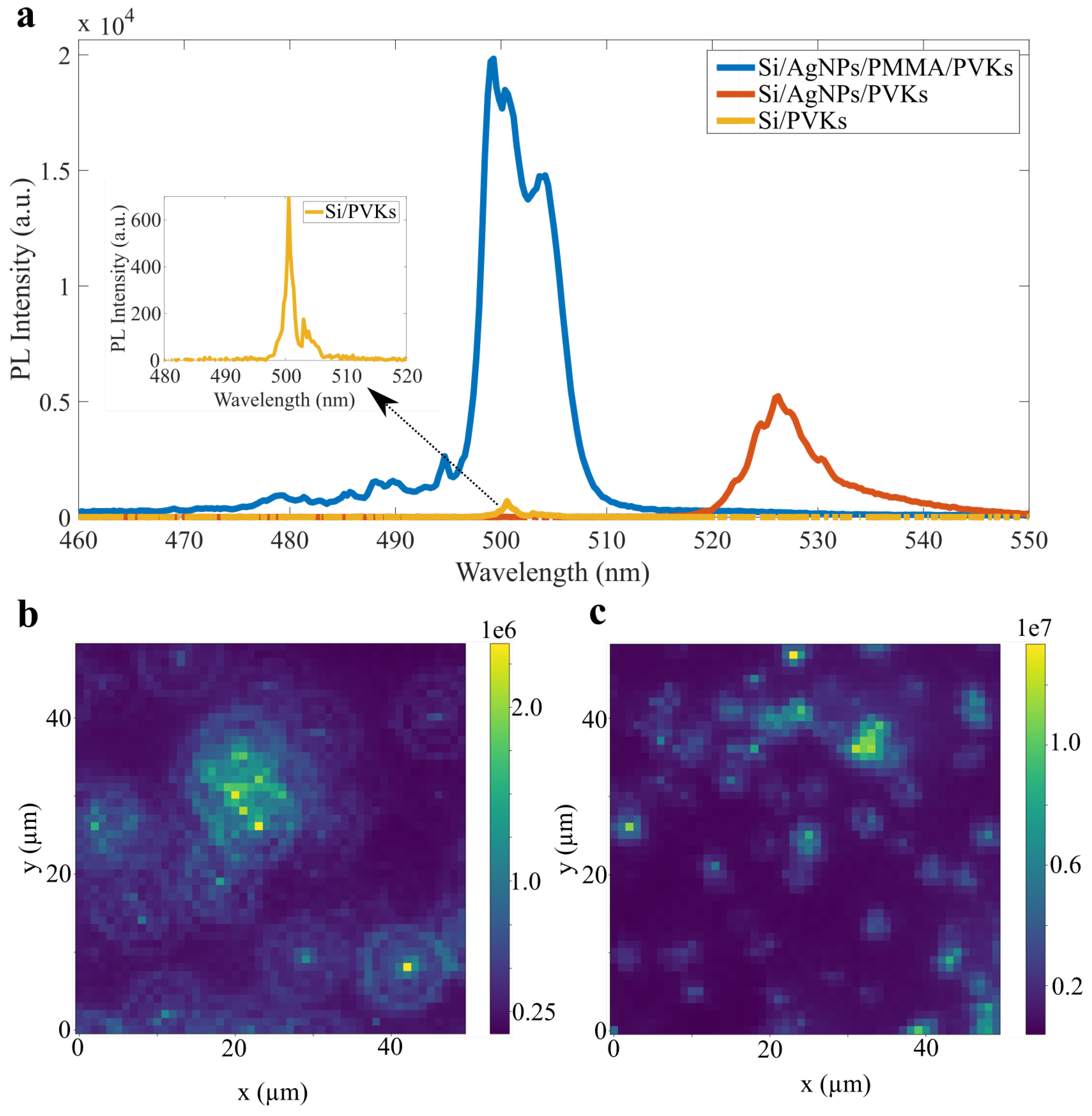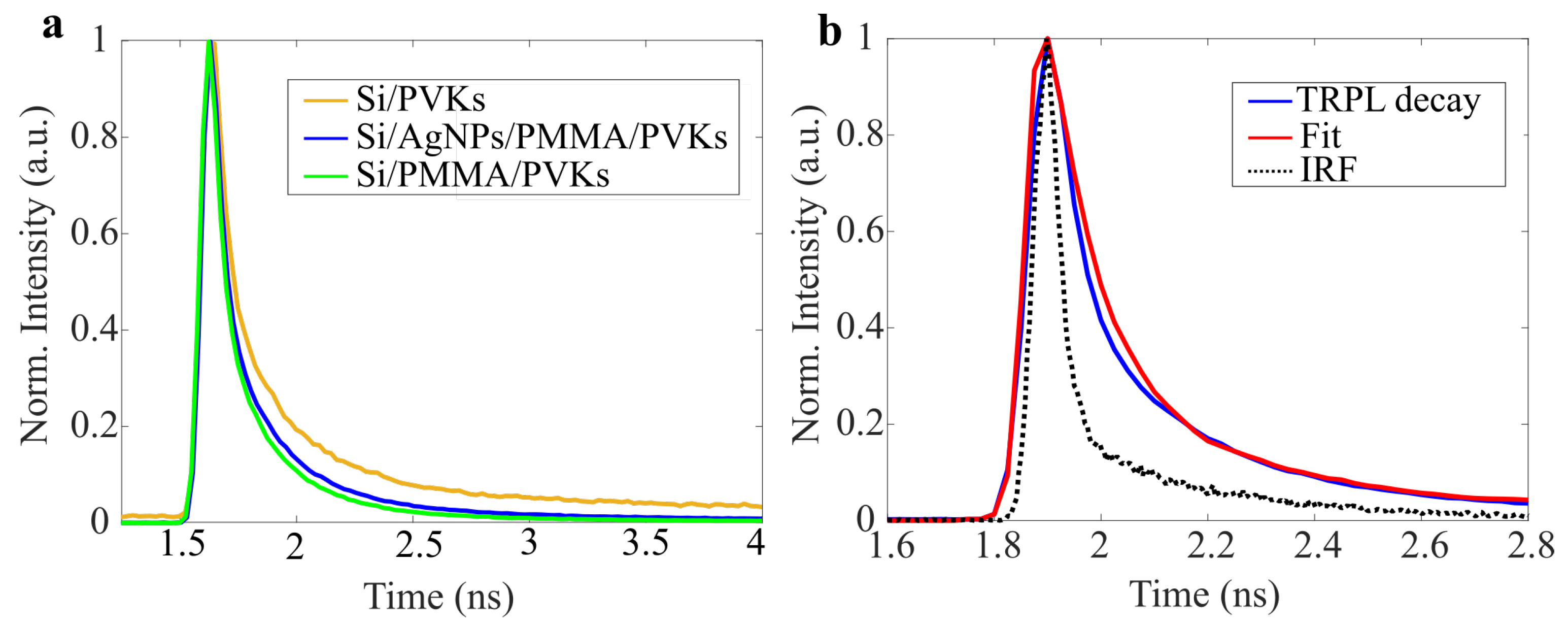Plasmon-Enhanced Photo-Luminescence Emission in Hybrid Metal–Perovskite Nanowires
Abstract
1. Introduction
2. Design and Fabrication of a Metal–Perovskite Nanowire Device
3. Optical Characterization
4. Conclusions
Supplementary Materials
Author Contributions
Funding
Data Availability Statement
Conflicts of Interest
References
- Yan, R.; Gargas, D.; Yang, P. Nanowire photonics. Nat. Photonics 2009, 3, 569–576. [Google Scholar] [CrossRef]
- Cretì, A.; Prete, P.; Lovergine, N.; Lomascolo, M. Enhanced Optical Absorption of GaAs Near-Band-Edge Transitions in GaAs/AlGaAs Core–Shell Nanowires: Implications for Nanowire Solar Cells. ACS Appl. Nano Mater. 2022, 5, 18149–18158. [Google Scholar] [CrossRef]
- Park, H.C.; Isnaeni; Gong, S.; Cho, Y.H. How Effective is Plasmonic Enhancement of Colloidal Quantum Dots for Color-Conversion Light-Emitting Devices? Small 2017, 13, 1701805. [Google Scholar] [CrossRef] [PubMed]
- Gudiksen, M.S.; Lauhon, L.J.; Wang, J.; Smith, D.C.; Lieber, C.M. Growth of nanowire superlattice structures for nanoscale photonics and electronics. Nature 2002, 415, 617–620. [Google Scholar] [CrossRef]
- Eaton, S.W.; Fu, A.; Wong, A.B.; Ning, C.Z.; Yang, P. Semiconductor nanowire lasers. Nat. Rev. Mater. 2016, 1, 16028. [Google Scholar] [CrossRef]
- Patolsky, F.; Timko, B.P.; Yu, G.; Fang, Y.; Greytak, A.B.; Zheng, G.; Lieber, C.M. Detection, Stimulation, and Inhibition of Neuronal Signals with High-Density Nanowire Transistor Arrays. Science 2006, 313, 1100–1104. [Google Scholar] [CrossRef]
- Feng, A.L.; You, M.L.; Tian, L.; Singamaneni, S.; Liu, M.; Duan, Z.; Lu, T.J.; Xu, F.; Lin, M. Distance-Dependent Plasmon-Enhanced Fluorescence of Upconversion Nanoparticles using Polyelectrolyte Multilayers as Tunable Spacers. Sci. Rep. 2015, 5, 7779. [Google Scholar] [CrossRef]
- Zhang, D.; Eaton, S.W.; Yu, Y.; Dou, L.; Yang, P. Solution-Phase Synthesis of Cesium Lead Halide Perovskite Nanowires. J. Am. Chem. Soc. 2015, 137, 9230–9233. [Google Scholar] [CrossRef]
- Eaton, S.W.; Lai, M.; Gibson, N.A.; Wong, A.B.; Dou, L.; Ma, J.; Wang, L.W.; Leone, S.R.; Yang, P. Lasing in robust cesium lead halide perovskite nanowires. Proc. Natl. Acad. Sci. USA 2016, 113, 1993–1998. [Google Scholar] [CrossRef]
- Chen, Y.; Zhang, Y.; Bao, L.; Liu, W.; Zhang, Y. Plasmon-Enhanced Blue Photoluminescence Efficiency from CsPb(Br/Cl)3 Perovskite Nanocrystals by Silver Nanoparticles. J. Phys. Chem. C 2021, 125, 10631–10638. [Google Scholar] [CrossRef]
- Zhang, D.; Yang, Y.; Bekenstein, Y.; Yu, Y.; Gibson, N.A.; Wong, A.B.; Eaton, S.W.; Kornienko, N.; Kong, Q.; Lai, M.; et al. Synthesis of Composition Tunable and Highly Luminescent Cesium Lead Halide Nanowires through Anion-Exchange Reactions. J. Am. Chem. Soc. 2016, 138, 7236–7239. [Google Scholar] [CrossRef] [PubMed]
- Protesescu, L.; Yakunin, S.; Bodnarchuk, M.I.; Krieg, F.; Caputo, R.; Hendon, C.H.; Yang, R.X.; Walsh, A.; Kovalenko, M.V. Nanocrystals of Cesium Lead Halide Perovskites (CsPbX3, X = Cl, Br, and I): Novel Optoelectronic Materials Showing Bright Emission with Wide Color Gamut. Nano Lett. 2015, 15, 3692–3696. [Google Scholar] [CrossRef] [PubMed]
- Imran, M.; Di Stasio, F.; Dang, Z.; Canale, C.; Khan, A.H.; Shamsi, J.; Brescia, R.; Prato, M.; Manna, L. Colloidal Synthesis of Strongly Fluorescent CsPbBr3 Nanowires with Width Tunable down to the Quantum Confinement Regime. Chem. Mater. 2016, 28, 6450–6454. [Google Scholar] [CrossRef]
- Ma, G.H.; He, J.; Rajiv, K.; Tang, S.H.; Yang, Y.; Nogami, M. Observation of resonant energy transfer in Au:CdS nanocomposite. Appl. Phys. Lett. 2004, 84, 4684–4686. [Google Scholar] [CrossRef]
- You, Q.; Li, Z.; Li, Y.; Qiu, L.; Bi, X.; Zhang, L.; Zhang, D.; Fang, Y.; Wang, P. Resonance Photoluminescence Enhancement of Monolayer MoS2 via a Plasmonic Nanowire Dimer Optical Antenna. ACS Appl. Mater. Interfaces 2022, 14, 23756–23764. [Google Scholar] [CrossRef] [PubMed]
- Lin, H.Y.; Chen, Y.F.; Wu, J.G.; Wang, D.I.; Chen, C.C. Carrier transfer induced photoluminescence change in metal-semiconductor core-shell nanostructures. Appl. Phys. Lett. 2006, 88, 161911. [Google Scholar] [CrossRef]
- Okamoto, K.; Vyawahare, S.; Scherer, A. Surface-plasmon enhanced bright emission from CdSe quantum-dot nanocrystals. J. Opt. Soc. Am. B 2006, 23, 1674–1678. [Google Scholar] [CrossRef]
- Maslov, A.V.; Ning, C.Z. Size reduction of a semiconductor nanowire laser by using metal coating. In Proceedings of the Physics and Simulation of Optoelectronic Devices XV, SPIE, San Jose, CA, USA, 20–25 January 2007; Volume 6468, pp. 138–144. [Google Scholar] [CrossRef]
- Yang, S.; Ellis, A.M.; Spence, D.; Feng, C.; Boatwright, A.; Latimer, E.; Binns, C. Growing metal nanoparticles in superfluid helium. Nanoscale 2013, 5, 11545–11553. [Google Scholar] [CrossRef]
- Toropov, N.; Kamalieva, A.; Starovoytov, A.; Zaki, S.; Vartanyan, T. Polarized Stimulated Emission of 2D Ensembles of Plasmonic Nanolasers. Adv. Photonics Res. 2021, 2, 2000083. [Google Scholar] [CrossRef]
- Semaltianos, N.G. Spin-coated PMMA films. Microelectron. J. 2007, 38, 754–761. [Google Scholar] [CrossRef]
- Kuriakose, T.; Renversez, G.; Nazabal, V.; Elsawy, M.M.R.; Coulon, N.; Němec, P.; Chauvet, M. Nonlinear Self-Confined Plasmonic Beams: Experimental Proof. ACS Photonics 2020, 7, 2562–2570. [Google Scholar] [CrossRef]
- Shang, Q.; Zhang, S.; Liu, Z.; Chen, J.; Yang, P.; Li, C.; Li, W.; Zhang, Y.; Xiong, Q.; Liu, X.; et al. Surface Plasmon Enhanced Strong Exciton–Photon Coupling in Hybrid Inorganic–Organic Perovskite Nanowires. Nano Lett. 2018, 18, 3335–3343. [Google Scholar] [CrossRef]
- Shugabaev, T.; Gridchin, V.O.; Melnichenko, I.A.; Bulkin, P.; Abramov, A.N.; Kuznetsov, A.; Maksimova, A.A.; Novikov, I.A.; Khrebtov, A.I.; Ubyivovk, Y.V.; et al. Surface Plasmon Polariton Photoluminescence Enhancement of Single InP Nanowires with InAsP Quantum Wells. Phys. Status Solidi (RRL)–Rapid Res. Lett. 2025, 19, 2400296. [Google Scholar] [CrossRef]
- Kao, T.S.; Hong, K.B.; Chou, Y.H.; Huang, J.F.; Chen, F.C.; Lu, T.C. Localized surface plasmon for enhanced lasing performance in solution-processed perovskites. Opt. Express 2016, 24, 20696–20702. [Google Scholar] [CrossRef] [PubMed]
- Wu, X.; Jiang, X.F.; Hu, X.; Zhang, D.F.; Li, S.; Yao, X.; Liu, W.; Yip, H.L.; Tang, Z.; Xu, Q.H. Highly stable enhanced near-infrared amplified spontaneous emission in solution-processed perovskite films by employing polymer and gold nanorods. Nanoscale 2019, 11, 1959–1967. [Google Scholar] [CrossRef]
- Adamo, G.; Swaha Krishnamoorthy, H.N.; Cortecchia, D.; Chaudhary, B.; Nalla, V.; Zheludev, N.I.; Soci, C. Metamaterial Enhancement of Metal-Halide Perovskite Luminescence. Nano Lett. 2020, 20, 7906–7911. [Google Scholar] [CrossRef]
- Kuriakose, T.; Walker, P.M.; Dowling, T.; Kyriienko, O.; Shelykh, I.A.; St-Jean, P.; Zambon, N.C.; Lemaître, A.; Sagnes, I.; Legratiet, L.; et al. Few-photon all-optical phase rotation in a quantum-well micropillar cavity. Nat. Photonics 2022, 16, 566–569. [Google Scholar] [CrossRef]
- Baig, N.; Kammakakam, I.; Falath, W. Nanomaterials: A review of synthesis methods, properties, recent progress, and challenges. Mater. Adv. 2021, 2, 1821–1871. [Google Scholar] [CrossRef]
- Grammatikopoulos, P.; Bouloumis, T.; Steinhauer, S. Gas-phase synthesis of nanoparticles: Current application challenges and instrumentation development responses. Phys. Chem. Chem. Phys. 2023, 25, 897–912. [Google Scholar] [CrossRef]
- Karafinski, B.; Sinha, N. Current trends in macromolecular synthesis of inorganic nanoparticles. MRS Commun. 2024, 14, 862–875. [Google Scholar] [CrossRef]
- Li, G.; Zakharov, D.N.; Sikder, S.; Xu, Y.; Tong, X.; Dimitrakellis, P.; Boscoboinik, J.A. In Situ Monitoring of Non-Thermal Plasma Cleaning of Surfactant Encapsulated Nanoparticles. Phys. Chem. Chem. Phys. 2023, 14, 290. [Google Scholar] [CrossRef] [PubMed]
- Yaqoob, A.A.; Umar, K.; Ibrahim, M.N.M. Silver nanoparticles: Various methods of synthesis, size affecting factors and their potential applications—A review. Appl. Nanosci. 2020, 10, 1369–1378. [Google Scholar] [CrossRef]
- Song, L.; Wang, Y.; Yang, M.; Huang, Y. Investigation on stability of silver nanoparticles with different ligands. J. Nanoparticle Res. 2023, 25, 255. [Google Scholar] [CrossRef]
- Pobell, F. Matter and Methods at Low Temperatures; Springer: Berlin/Heidelberg, Germany, 2007. [Google Scholar] [CrossRef]





Disclaimer/Publisher’s Note: The statements, opinions and data contained in all publications are solely those of the individual author(s) and contributor(s) and not of MDPI and/or the editor(s). MDPI and/or the editor(s) disclaim responsibility for any injury to people or property resulting from any ideas, methods, instructions or products referred to in the content. |
© 2025 by the authors. Licensee MDPI, Basel, Switzerland. This article is an open access article distributed under the terms and conditions of the Creative Commons Attribution (CC BY) license (https://creativecommons.org/licenses/by/4.0/).
Share and Cite
Kuriakose, T.; Sha, H.; Wang, Q.; Topcu, G.; Romain, X.; Yang, S.; Taylor, R.A. Plasmon-Enhanced Photo-Luminescence Emission in Hybrid Metal–Perovskite Nanowires. Nanomaterials 2025, 15, 608. https://doi.org/10.3390/nano15080608
Kuriakose T, Sha H, Wang Q, Topcu G, Romain X, Yang S, Taylor RA. Plasmon-Enhanced Photo-Luminescence Emission in Hybrid Metal–Perovskite Nanowires. Nanomaterials. 2025; 15(8):608. https://doi.org/10.3390/nano15080608
Chicago/Turabian StyleKuriakose, Tintu, Hao Sha, Qingyu Wang, Gokhan Topcu, Xavier Romain, Shengfu Yang, and Robert A. Taylor. 2025. "Plasmon-Enhanced Photo-Luminescence Emission in Hybrid Metal–Perovskite Nanowires" Nanomaterials 15, no. 8: 608. https://doi.org/10.3390/nano15080608
APA StyleKuriakose, T., Sha, H., Wang, Q., Topcu, G., Romain, X., Yang, S., & Taylor, R. A. (2025). Plasmon-Enhanced Photo-Luminescence Emission in Hybrid Metal–Perovskite Nanowires. Nanomaterials, 15(8), 608. https://doi.org/10.3390/nano15080608







